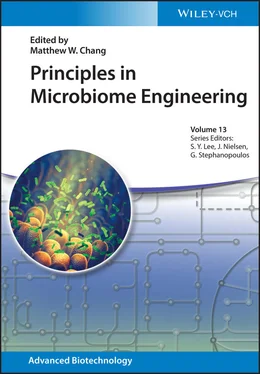Principles in Microbiome Engineering
Здесь есть возможность читать онлайн «Principles in Microbiome Engineering» — ознакомительный отрывок электронной книги совершенно бесплатно, а после прочтения отрывка купить полную версию. В некоторых случаях можно слушать аудио, скачать через торрент в формате fb2 и присутствует краткое содержание. Жанр: unrecognised, на английском языке. Описание произведения, (предисловие) а так же отзывы посетителей доступны на портале библиотеки ЛибКат.
- Название:Principles in Microbiome Engineering
- Автор:
- Жанр:
- Год:неизвестен
- ISBN:нет данных
- Рейтинг книги:5 / 5. Голосов: 1
-
Избранное:Добавить в избранное
- Отзывы:
-
Ваша оценка:
- 100
- 1
- 2
- 3
- 4
- 5
Principles in Microbiome Engineering: краткое содержание, описание и аннотация
Предлагаем к чтению аннотацию, описание, краткое содержание или предисловие (зависит от того, что написал сам автор книги «Principles in Microbiome Engineering»). Если вы не нашли необходимую информацию о книге — напишите в комментариях, мы постараемся отыскать её.
Provides an overview of the techniques and applications insight into the complex composition and interactions of microbiomes Principles in Microbiome Engineering
Principles in Microbiome Engineering
Principles in Microbiome Engineering — читать онлайн ознакомительный отрывок
Ниже представлен текст книги, разбитый по страницам. Система сохранения места последней прочитанной страницы, позволяет с удобством читать онлайн бесплатно книгу «Principles in Microbiome Engineering», без необходимости каждый раз заново искать на чём Вы остановились. Поставьте закладку, и сможете в любой момент перейти на страницу, на которой закончили чтение.
Интервал:
Закладка:
Gastric microbiota is generally known to be acid‐tolerant, where these microbes need to survive under low pH conditions (pH 1–5). In a healthy individual, metagenomic analysis of the gastric microbiota showed an average abundance of Firmicutes (29.6%), Bacteroidetes (46.8%), Actinobacteria (11%), and Proteobacteria (10%). Among these phyla, the predominant genus includes those from the acid‐tolerant Streptococci , Lactobacilli , Staphylococci , and Neisseria spp. [18, 19] Dysbiosis resulting from Helicobacter pylori infection showed a massive shift of Proteobacteria abundance accounting for 93–97% of the total microbiota count [19]. The pathogen H. pylori preferentially localize at the upper gastric mucosa perturbing the gastric microbiota by reducing the microbial diversity and is linked to medical problems such as gastritis, peptic ulcers, and cancer [20].
The small intestine involved in nutrient absorption with a long, narrow, folded tube structure exhibits restricted nutrient accessibility to promote microbial growth. The primary composition of the small intestinal microbiota is from the Clostridium , Enterococcus , Oxalobacter , Streptococcus , and Veillonella genera. Despite the poor diversity, the microbiota composition fluctuates depending on the structure and the exposure to the digested chyme in the small intestine [21]. Most of the microbes colonizing the small intestine carry genes encoding for carbohydrate phosphotransferase that play a role in competitive carbohydrate uptake in the microbiome [22]. Dysbiosis in the small intestinal tract showing increased abundance of Bacteroides spp., Clostridium leptum, and Staphylococcus spp. is linked to pediatric celiac disease [23], while the increased abundance of Escherichia coli and Roseburia spp. is often observed in patients with ileal Crohn's disease [24].
The large intestine (including the cecum, colon, and rectum) has the highest microbiota density in the whole body with approximately 10 12cells per gram, weighing about 1.5 kg in an average adult. The colorectal microbiota is dominated by phyla Firmicutes and Bacteroidetes that account for more than 80% of the total microbial population in adults [25, 26]. Studies have shown that certain predominant species in the gut populate the colorectal region based on the presence of dietary nutrients. Bacteroides were found to be enriched in a carbohydrate‐rich diet, while dietary mucin and complex sugars encourage the abundance of Prevotella and Ruminococcus, respectively [27].
1.1.1.3 Skin Microbiome
Similar to the oral microbiome, skin microbiota varies at different locations depending on the presence of hair, sebum secretion, moisture, host biochemistry, and exposure to air [28]. The primary colonizers of the skin surfaces are predominantly Staphylococcus epidermidis, other coagulase‐negative Staphylococci , and Actinobacteria (from the genera Corynebacterium, Propionibacterium, Brevibacterium, and Micrococcus ) [28] ( Figure 1.1). The skin microbiota confers direct health benefits by occupying a wide range of skin, generating a shielding effect from the environmental pathogenic [28]. Through indirect interaction, certain skin commensal microbes can thrive in the subepidermal layer [29], establishing a link between the skin microbiome and the host immune system. Additionally, skin microbiota is known to affect the food quality particularly in fermented foods, where the by‐products of the fermentation, in turn, affect the host gut microbiota [30].
1.1.1.4 Respiratory Microbiome
The current studies of the human respiratory microbiome focus on the lung microbiota, particularly in the bronchial microbiome. Samples of the human lungs are acquired using a deep nasal swab (for nasopharyngeal sampling) [31] and sputum collection (for bronchoalveolar sampling) [32]. In the lungs of a healthy person, the typical microbiota includes those from the genera of Firmicutes, Bacteroidetes, Proteobacteria, Fusobacteria , and Actinobacteria [33, 34] ( Figure 1.1). These microbes thrive at mucosal surfaces of both the lung and bronchus where the exchange of oxygen and carbon dioxide happens; therefore, most of these microbes are facultative anaerobes able to survive in the varying levels of oxygen [9]. While the study of the respiratory microbiome requires further in‐depth understanding, these microbes certainly play an important role in various respiratory diseases such as bacterial pneumonia, cystic fibrosis, asthma, and chronic obstructive pulmonary disease (COPD) [31].
1.1.1.5 Urogenital Microbiome
The urogenital microbiome interacts with various aerobic and anaerobic microorganisms with the host, including microbes from the bladder [35, 36] and reproductive tract [37]. The microbiota bladder and urinary tract include aerobic bacteria such as E. coli and Enterococcus faecalis [38], and anaerobic bacteria such as Corynebacterium , Lactobacillus , and Ureaplasma [39–41]. The vaginal microbiota comprises mainly Lactobacillus spp. and Bifidobacterium [42] that prevent pathogenic infections by acidifying the lower genital tract. Patients suffering from interstitial cystitis showed lower bacterial diversity with enriched populations of Lactobacillus (92% of the total microbial population) compared to the abundance in healthy individuals (57% of the total microbial population) [35]. The changes in urogenital microbiota were found to be linked to other medical ailments and chronic inflammatory diseases such as inflammatory bowel disease (IBD) [43], suggesting a link between the urogenital microbiome and the digestive tract. Therefore, the study of the urogenital microbiome can be used as a good indicator to determine the host health by using patient urine samples.
1.1.2 Elements that Influence Microbiome Development
Various elements play a role in shaping the respective microbiome in the human body. Extensive studies comparing the variation of the gut and skin microbiome of twins suggest that the genetic component does play some role in modulating the microbiome, it is the daily habits, interactions, and age that has a stronger influence on the development of the microbiome [44, 45]. A longitudinal study conducted to investigate the oral microbiome variation between monozygotic and dizygotic twins showed that diet plays an important role to shape the microbiome. This study looks at the demineralization of enamel and salivatory composition that showed that food preferences and eating habits (including eating etiquette) help shape the microbial community. These include the formation of multispecies biofilm communities that establishes a stronger foothold in the microbiome. It was shown that there are great variations between the microbiome of twins, although there is a closer similarity of microbiome between monozygotic twins in comparison to dizygotic ones [44]. In another study comparing the core gut microbiome of obese and lean twins similarly showed variation between the microbiome of twins, where monozygotic twins have closer similarity to each other, while dizygotic twins were shown to resemble the maternal microbiome. This observation is similar for both obese and lean twins observed in this study [45]. Thus, it is certain that the dietary role plays an important factor in the establishment and maintenance of the host microbiome. This will be discussed at length in the sub chapter 1.2, addressing the nutrition‐based role in changing the microbiome landscape. However, before we delve into sub chapter 1.2, we here address basic terminologies used in the following part of this chapter.
Читать дальшеИнтервал:
Закладка:
Похожие книги на «Principles in Microbiome Engineering»
Представляем Вашему вниманию похожие книги на «Principles in Microbiome Engineering» списком для выбора. Мы отобрали схожую по названию и смыслу литературу в надежде предоставить читателям больше вариантов отыскать новые, интересные, ещё непрочитанные произведения.
Обсуждение, отзывы о книге «Principles in Microbiome Engineering» и просто собственные мнения читателей. Оставьте ваши комментарии, напишите, что Вы думаете о произведении, его смысле или главных героях. Укажите что конкретно понравилось, а что нет, и почему Вы так считаете.












